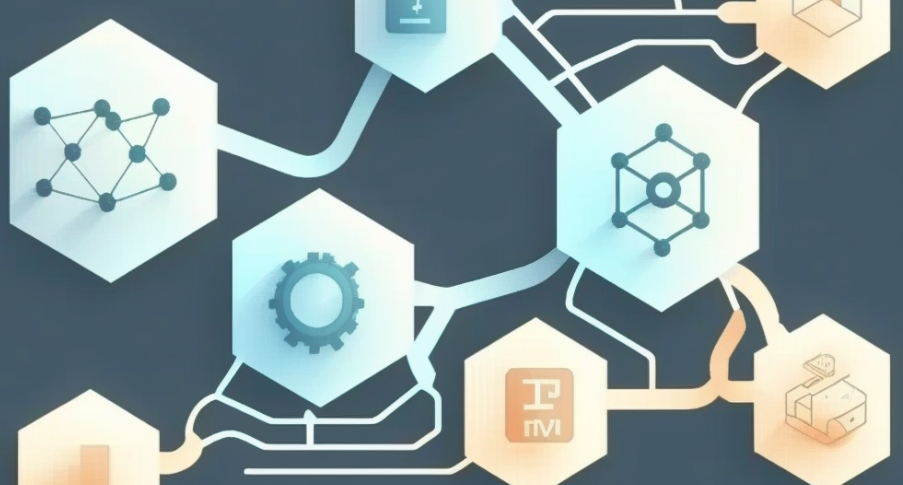
All DeFi development tools on the Ethereum blockchain can be divided into two large groups: those related to the development of applications based on the Ethereum blockchain and Solidity language, and those that use a low-code approach. These include Decentology, ThirdWeb and Bunzz. They reduce the amount of code a programmer needs to write by using smart modules that consist of Solidity smart contracts and UI elements. UI elements and other backend elements can also be written in other programming languages.
Decentology Toolkit
The Decentology toolkit is designed for developers who interact with the blockchain via the JavaScript programming language. This is low-code DeFi programming, which reduces the writing of program code to a minimum. It uses the concept of Smart Modules, which replace smart contracts and serve to build DeFi applications. Smart Modules include smart contracts, as well as unit tests, JavaScript APIs, and UI elements.
To run the smart modules, you’ll need to clone the application from GitHub and install an IDE for editing JavaScript, such as Visual Studio Code. In addition, Git, Node.js and Pnpm must be installed.
After cloning the Hyperverse Monorepo package on GitHub, you will get Hyperverse Core plus a set of utilities and software libraries to work with the smart modules.
Smart modules can work with blockchains such as:
- Ethereum.
- Flow.
- Metis.
- Algorand.
- Polygon
- Celo.
- Binance Smart Chain (BSC).
They also support decentralized storage. There is everything you need to work with ERC-20 (custom coins) and ERC-721 (NFT) tokens. Smart contracts, which are at the lowest level of smart modules, are written in Solidity. UI elements for user interaction are written in the JavaScript programming language.
Thirdweb platform for developing smart contracts
The Thirdweb platform is a web3 development framework that includes a variety of software products:
- SDK. Integrate Web3 functions into dApp.
- Explore. Ready-to deploy contracts.
- ContractKit. Section for creation of smart contracts.
- Dashboards. Management and analysis of contract’s activity.
- UI components. Plug-and-play frontend components.
- Auth. User authentication with the wallet mechanism.
- Release. A way to publish the created contract on-chain.
- Deploy. A tool for contract deployment for teams.
- Storage. Secure, fast, decentralized storage.
The Thirdweb platform supports the following programming languages
- JavaScript.
- React.
- Go.
- Python.
- Unity.
Smart contracts, SDKs, UIs and other Thirdweb components are open source. The developer himself fully owns all the software code, there are no code modules owned by third parties.
Thirdweb enables the development of smart contracts for these blockchains:
- Ethereum.
- Solana.
- Polygon.
- Flow.
- Avalanche.
- Optimism.
- Fantom.
- Arbitrum.
The Bunzz platform for developing dApps
Bunzz is one of the easiest ways to create smart contracts. There’s a GUI that eliminates the need to learn blockchain-related programming languages. The development of dApps for blockchains like:
- Ethereum.
- Arbitrum.
- Polygon.
- Avalanche.
- Binance Smart Chain.
- Astar.
The platform also includes a variety of software products. Among them:
- Bunzz Console – You can deploy smart contracts in minutes.
- Bunzz SDK. Designed to build a frontend app that interacts with smart contracts.
- Bunzz Smart Contract Hub. Here the developer can create templates for the modules he wants to use.
- Bunzz Monitoring. A section for displaying statistics about the used smart contracts.
Using Bunzz will be an easy way to create ERC-20 (custom coins) and ERC-721 (NFT) tokens. The DApp basically consists of smart contracts, front-end, and back-end. Bunzz includes everything you need to build these components. There are all possibilities to link developed dApp with MetaMask wallet.
The front-end is written with bunzz-sdk. And the back-end is developed using modules. In turn, each module consists of separate smart contracts. The Bunzz SDK is a javascript library, and you will need to install it before you start.
Must-have developer tools: Metamask and Moralis
When developing DeFi, it’s hard to do without integration with the Metamask wallet. This is a browser extension as well as a mobile wallet created by ConsenSys. Metamask is not only a browser extension of the same name, but also a mobile wallet. It supports a large list of major decentralized networks and test blockchains. When developing your dApp, you should definitely consider how it will interact with Metamask. The Metamask SDK, which supports JavaScript, React, and React Native, is worth a look.
Experienced blockchain developers can’t do without the Moralis framework. It’s a toolkit with a powerful API and numerous features. There are Moralis streams for getting data from the underlying and test networks of different blockchains. And Moralis authentication technology allows you to authenticate users via an EVM-enabled wallet or Solana wallet. Moralis also indexes the blockchain, making it faster to interact with decentralized data.
Moralis makes it possible to develop applications for these blockchains:
- Ethereum.
- BNB.
- Polygon.
- Avalanche.
- Solana.
- Fantom.
- Cronos.
- Arbitrum.
- Aptos.
- Palm.
- Optimism.
Thus, with Moralis, you can go beyond the Ethereum blockchain to develop applications based on other blockchains. All of them have a similar structure and common core principles of operation.
Embark, Prysm and Web3j tools
A special feature of the Ethereum network is that it uses its own programming language for writing smart contracts, called Solidity. However, Solidity is not an easy language to master.
There are many tools that simplify development in this programming language. These include software libraries, smart contract templates, and frameworks. Experienced Ethereum developers also use tools such as Embark, Prysm and Web3j.
Embark is an all-in-one developer platform for building and deploying decentralized applications. It’s not just a framework for writing and deploying smart contracts. It’s also a development environment specifically designed for testing smart contracts in real-world environments. There are all the tools to interact with data that is stored in a decentralized way, such as IPFS and Whisper.
Prysm is an Ethereum proof-of-stake client written in Go. Web3j is used to interface Ethereum smart contracts and lightweight Java applications, including Android mobile apps.
Truffle Suite framework
Our review would not be complete without looking at the Truffle Suite framework. It includes tools for testing, compiling and deploying smart contracts. There are also libraries for interacting with wallets, user authentication, and other commonly used tasks.
Supported blockchains include:
- Ethereum.
- Tezos.
- Corda.
- Quorum.
- Filecoin.
- Hyperledger fabric (EVM).
Most of the low-level interaction with blockchains is moved to the abstraction layer, which makes the programmer’s job easier. Testing, debugging, deploying smart contracts – the Truffle Suite framework has handy tools for all these routine tasks. In addition, there are Truffle Boxes created by both the official publisher and the community. Truffle Boxes include components to interface with various web-based tools, such as ReactJS.
What you need to know before starting to build a dApp for Ethereum
Already well-known blockchains such as Ethereum have a large number of templates, frameworks and other tools for the developer. However, there are also limitations of these blockchains that set the framework for your future dApps. Young and up-and-coming blockchains have fewer ready-made templates and development tools. But with newer blockchains, your dApp could be a trailblazer in some areas. Therefore, don’t limit yourself to building a dApp for Ethereum. However, building a dApp for Ethereum blockchain is a good place to start in order to master the basics of creating decentralized applications.







